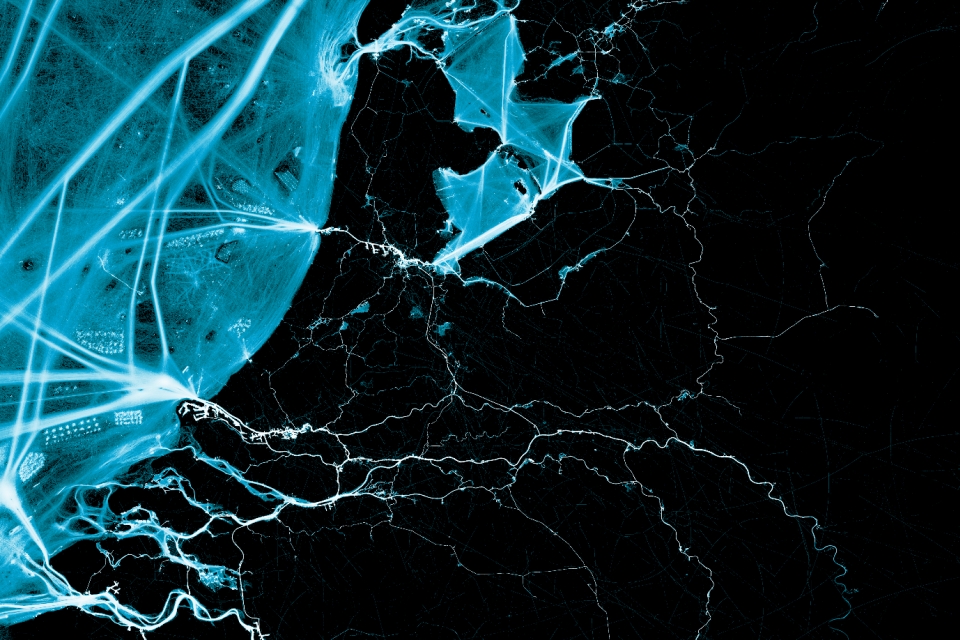The cover of SWZ|Maritime’s December edition shows something different than what readers are usually offered. Instead of an often brand-new ship in its elements, we show a map of the Netherlands and a big chunk of the Dutch part of the North Sea. And what this map shows very clearly, is how busy the North Sea is.
The brightly illuminated thick lines show the shipping routes. But it also shows a lot of other things as all the other smaller and bigger dots mean that there is something standing or floating at sea, such as offshore wind farms, with their turbines and transformer stations, the platforms, big and small, for the production of oil and gas, the designated anchoring areas for ships that wait to be dealt with at our ports and just here and there a fishing ship that catches badly needed healthy food for our dining tables.
All these functions at sea need construction, thinking and R&D to develop. Besides the bigger ships that are mostly designed and built in Asia nowadays, a lot of the fixed or floating objects and the smaller ships are still built at Dutch yards. The shows that the North Sea has long ceased to be that large open, empty plain where you don’t meet anyone until you reach the other side of the sea or ocean. On the contrary, sailing the North Sea means taking into account more and more rules, injunctions and prohibitions.
Also read: SWZ|Maritime’s November issue: The knowledge network of SWZ and the fishing industry
More restrictions for fishermen
Dutch fishermen in particular are experiencing ever more restrictions in practising their profession. For them, the headline on the cover of spatial planning means more and more often a battle for space, just like the farmers on land that are constantly faced with the encroachment of housing and business activity.
And just like on land, politicians have to choose constantly who gets priority. The government has developed spatial planning to bring the different interests in a dynamic balance and this will also have to happen for the North Sea.
Our editor Johan de Jong from MARIN has put this issue on the agenda of SWZ|Maritime by coordinating a range of articles about this subject with contributions of Rijkswaterstaat (the Dutch Directorate-General for Public Works and Water Management), fisheries lobbyist Pim Visser, Lloyd’s Register’s George Kallenos, and our editor Sander Klos.
And if the cover picture intrigues you as it does me and you are interested in what digitalisation of processes can offer us in terms of new interesting insights, you have to read the article of PhD candidate Solange van der Werff of the TU Delft. I hope our readers will enjoy reading these articles just as much as I have.
This is editor-in-chief Antoon Oosting’s editorial accompanying the December 2021 issue. Our digital archive is once again available to subscribers and can read the digitial version of our December issue there.. Subscribers can register here to gain access. Not yet a subscriber? Visit our subscription page.
The articles in SWZ|Maritime’s December issue
In addition to the regular sections such as Dutch news, Markets, Maritime monthly, Global news, Book reviews, Mars Report and news from the KNVTS, the articles (some in Dutch) in the December issue are:
- The North Sea in transition
- Marine spatial planning from a fisheries perspective
- AIS data analysed
- Naar een digitalisering van de Noordzee
- A changing landscape for offshore wind
- Wel of niet meepraten over ‘nieuwe’ Noordzee?
- Hypersonic missiles disrupt naval warfare
- Restoring confidence in the safety of container ships
- Metstrade not too much affected by pandemic
- Integrating IMDG and loading and stability software
Picture: Solange van der Werff (TU Delft) visualised the intensity of traffic on the North Sea using AIS data. The more vessels cross the same area, the brighter the colour becomes.
Also read: SWZ|Maritime’s October 2021 issue: ‘Finally, we can meet again in real life’








